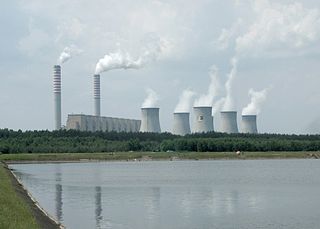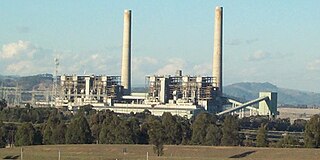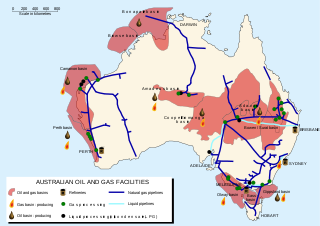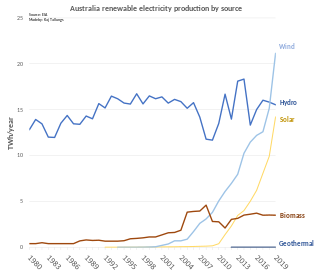
GenOn Energy, Inc., based in Houston, Texas, United States, is an energy company that provided electricity to wholesale customers in the United States. The company is one of the largest independent power producers in the nation with more than 7,000 megawatts of power generation capacity across the United States using natural gas, fuel oil and coal. GenOn Energy is headquartered in the Reliant Energy Plaza in Downtown Houston. The company, formerly known as RRI Energy, acquired Mirant on December 3, 2010. The corporate names and logos of both RRI Energy and Mirant were retired.

A fossil fuel power station is a thermal power station which burns a fossil fuel, such as coal or natural gas, to produce electricity. Fossil fuel power stations have machinery to convert the heat energy of combustion into mechanical energy, which then operates an electrical generator. The prime mover may be a steam turbine, a gas turbine or, in small plants, a reciprocating gas engine. All plants use the energy extracted from the expansion of a hot gas, either steam or combustion gases. Although different energy conversion methods exist, all thermal power station conversion methods have their efficiency limited by the Carnot efficiency and therefore produce waste heat.

"Mercury control from coal combustion". UNEP.{{cite web}}: CS1 maint: url-status (link)

The Yallourn Power Station, now owned by EnergyAustralia a wholly owned subsidiary of the Hong-Kong-based CLP Group, is located in the Latrobe Valley of Victoria, Australia, beside the Latrobe River, with the company town of Yallourn located to the south west. Yallourn PS was a complex of six brown coal–fired thermal power stations built progressively from the 1920s to the 1960s; all except one have now been decommissioned. Today, only the 1,450 megawatts (1,940,000 hp) Yallourn W plant remains. It is the second largest power station in Victoria, supplying 22% of Victoria's electricity and 8% of the National Electricity Market. The adjacent open cut brown coal mine is the largest open cut coal mine in Australia, with reserves sufficient to meet the projected needs of the power station to 2028. On 10 March 2021, EnergyAustralia announced that it will close the Yallourn Power Station in mid-2028, four years ahead of schedule, and instead build a 350 megawatt battery in the Latrobe Valley by the end of 2026. At the time, Yallourn produced about 20% of Victoria's electricity.

Vales Point Power Station is one of two operating coal fired power stations on the shores of Lake Macquarie, New South Wales. Vales Point is located on the southern shore of the lake, near the township of Mannering Park. It has two steam turbines, with a total generating capacity of 1,320 MW (1,770,000 hp) of electricity.

Liddell Power Station is a decommissioned coal-fired thermal power station that had four 500 megawatts (670,000 hp) EE steam-driven turbine alternators, providing a combined electrical capacity of 2,000 megawatts (2,700,000 hp).
Mount Piper Power Station is a coal powered power station with two steam turbines with a combined generating capacity of 1,400 MW of electricity. It is located near Portland, in the Central West of New South Wales, Australia and owned by EnergyAustralia, a subsidiary of CLP Group. On 23 September 2021, it was announced that the closure of the power station is being brought forward from 2042 to 2040 at the latest. The power station employs 250 workers.

Wallerawang Power Station was a thermal coal power station, located near Wallerawang, in the Central Tablelands region of New South Wales, Australia. The power station was equipped with two turbo-alternators of 500 megawatts (670,000 hp) each, supplied by CA Parsons and Company of Newcastle-upon-Tyne, England. Production commenced in May 1957.
Playford B Power Station was located at Port Paterson in the Australian state of South Australia about 5.5 kilometres (3.4 mi) south of the city centre of Port Augusta. It was coal powered with four 60 MW steam turbines that generated a total of 240 MW of electricity. Playford B received coal by rail from the Leigh Creek Coal Mine, 280 km to the north and drew cooling water from Spencer Gulf, returning it to the sea at an elevated temperature. Commissioned in 1963, it was co-located with the older Playford A Power Station and the larger, newer Northern Power Station. Playford B was mothballed in 2012 and its permanent closure was announced by operator Alinta Energy in October 2015. Prior to being mothballed, it primarily operated in the summer, when electricity demand peaks.

Callide Power Station is an electricity generator at Mount Murchison, Shire of Banana, Queensland, Australia. It is coal powered with eight steam turbines with a combined generation capacity of 1,720 megawatts (MW) of electricity. Callide A was commissioned in 1965, refurbished in 1998 and decommissioned in 2015/16. As of 2018, generation capacity was 1510 MW.
Collinsville Power Station is located in Collinsville, Whitsunday Region, Queensland, Australia. It had five coal powered steam turbines with a combined generation capacity of 190 MW of electricity. The coal-fired power station closed in 2013. A solar power farm generating 42MW has been built on adjacent land.

The energy policy of Australia is subject to the regulatory and fiscal influence of all three levels of government in Australia, although only the State and Federal levels determine policy for primary industries such as coal. Federal policies for energy in Australia continue to support the coal mining and natural gas industries through subsidies for fossil fuel use and production. Australia is the 10th most coal-dependent country in the world. Coal and natural gas, along with oil-based products, are currently the primary sources of Australian energy usage and the coal industry produces over 30% of Australia's total greenhouse gas emissions. In 2018 Australia was the 8th highest emitter of greenhouse gases per capita in the world.

Renewable energy in Australia includes wind power, hydroelectricity, solar photovoltaics, heat pumps, geothermal, wave and solar thermal energy.

The Kogan Creek Power Station is a 750 megawatt coal fired power station owned by CS Energy on the Darling Downs in Queensland. The $1.2 billion plant is situated at Brigalow, in the Surat Basin between Dalby and Chinchilla.

Ensuring adequate energy supply to sustain economic growth has been a core concern of the Chinese government since 1949. The country is the world's largest emitter of greenhouse gases, and coal in China is a major cause of global warming. However, from 2010 to 2015 China reduced energy consumption per unit of GDP by 18%, and CO2 emissions per unit of GDP by 20%. On a per-capita basis, it was the world's 51st largest emitter of greenhouse gases in 2016. China is also the world's largest renewable energy producer. China is the largest producer of hydroelectricity, solar power and wind power in the world. The energy policy of China is connected to its industrial policy. The goals of China's industrial policy dictate its energy needs.

A coal-fired power station or coal power plant is a thermal power station which burns coal to generate electricity. Worldwide there are over 2,400 coal-fired power stations, totaling over 2,000 gigawatts capacity. They generate about a third of the world's electricity, but cause many illnesses and the most early deaths, mainly from air pollution.

Queensland's energy policy is based on the year 2000 document called the Queensland Energy Policy: A Cleaner Energy Strategy. The Queensland Government assists energy development through the Department of Energy and Water Supply. The state is noted for its significant contribution to coal mining in Australia. The primary fuel for electricity generation in the state is coal with coal seam gas becoming a significant fuel source. Queensland has 98% of Australia's reserves of coal seam gas. An expansion of energy-intensive industries such as mining, economic growth and population growth have created increased demand for energy in Queensland.
Carbon capture and storage (CCS) is a technology that can capture carbon dioxide CO2 emissions produced from fossil fuels in electricity, industrial processes which prevents CO2 from entering the atmosphere. Carbon capture and storage is also used to sequester CO2 filtered out of natural gas from certain natural gas fields. While typically the CO2 has no value after being stored, Enhanced Oil Recovery uses CO2 to increase yield from declining oil fields.

Energy in Australia is the production in Australia of energy and electricity, for consumption or export. Energy policy of Australia describes the politics of Australia as it relates to energy.

Coal phase-out is an environmental policy intended to stop using the combustion of coal in coal-burning power plants, and is part of fossil fuel phase-out. Coal is the most carbon-intensive fossil fuel, therefore phasing it out is critical to limiting climate change and keeping global warming to 1.5 °C as laid out in the Paris Climate Agreement. The International Energy Agency (IEA) estimates that coal is responsible for over 30% of the global average temperature increase above pre-industrial levels.

















